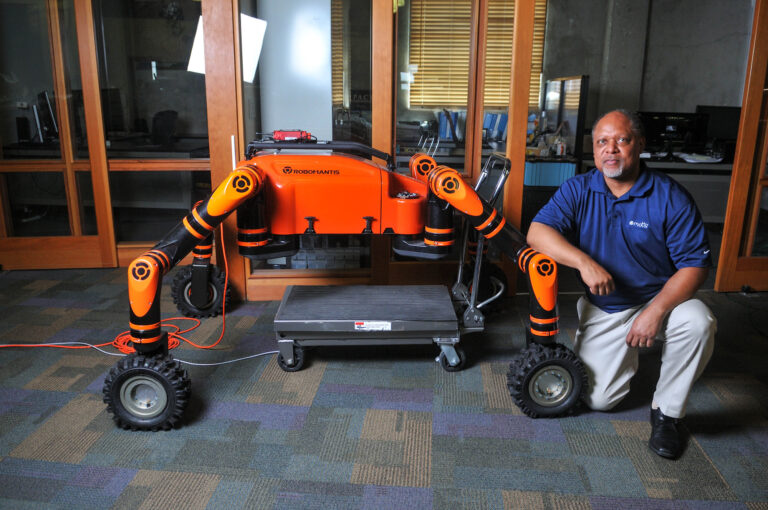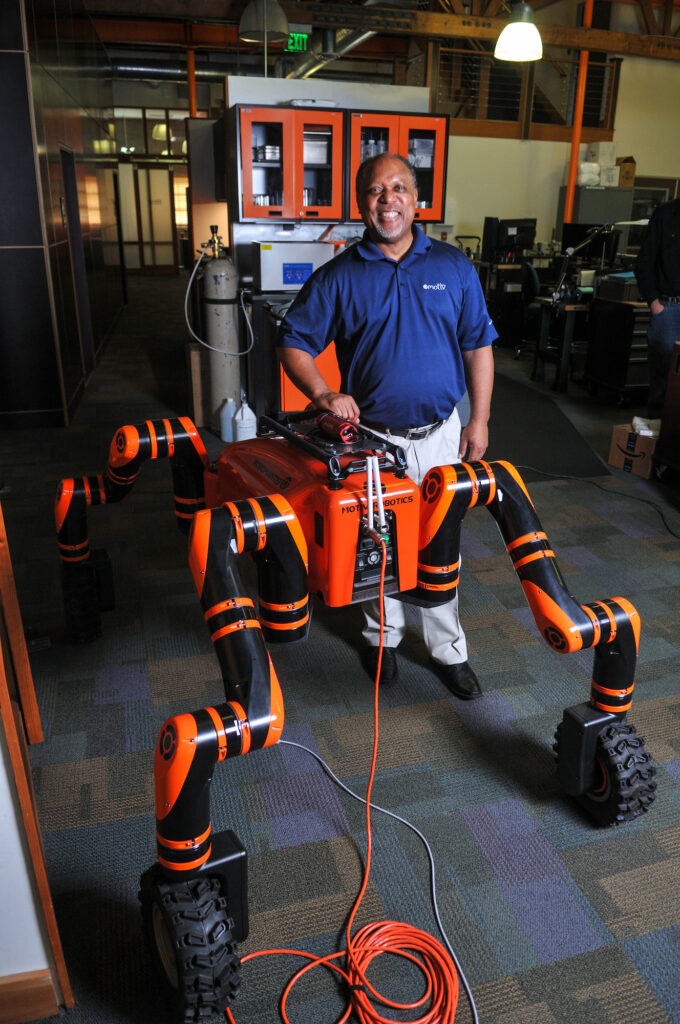
Contributing to a project that will send three rovers to the moon gives Motiv Space Systems a chance to spread its wings.
The Pasadena-based aerospace company was chosen by NASA and the Jet Propulsion Laboratory, which manages the Cooperative Autonomous Distributed Robotic Exploration project for the space agency, to develop and build numerous hardware components for the project, which will send a trio of robotic rovers to the moon next year.
It is one of about a half dozen lunar and Mars-related exploration programs the company is involved with.
Motiv has been involved with rovers before this – namely providing the robotic arm for the Mars Perseverance rover currently exploring the red planet.
Eddie Tunstel, the chief technology officer for Motiv, said that while the company has built robotic arms for the Mars rover program, this mission is the first time it has developed, built and delivered rover hardware that includes a mobility system and a number of other systems.
“It really expands what we have been doing of late,” Tunstel said.
Attempts to reach a representative of the Jet Propulsion Laboratory in La Canada-Flintridge for further comment on the mission and Motiv’s role in it were not successful.
But Subha Comandur, the project manager at JPL, said in a statement that the mission is designed to demonstrate that a network of mobile robots can cooperate to accomplish a task without human intervention – autonomously.
“It could change how we do exploration in the future,” Comandur said. “The question for future missions will become: ‘How many rovers do we send, and what will they do together?’”
Device specs
The lunar rovers, which are the size of a carry-on bag, are being assembled at JPL. The staff there is integrating the systems developed and built by Motiv.
The company is practically done with its part of the mission, except for supporting JPL through the assembly, testing and launch-operations process, Tunstel said.
“This is where they take our hardware and the subsystems that we have built and delivered and they integrate them and assemble them with all the rest of the parts that JPL has built that make up the rest of the system itself,” he added.
The company built the chassis, the actuators and the motor controllers of the rovers. It also designed and built the deployers that are used to get the rovers to the lunar surface.
“So we’ve got motor controllers distributed across the deployers as well as the rovers themselves,” Tunstel said.
After the rovers have landed on the moon, one of the first things they do is open their solar panels from a folded position, Tunstel continued, adding, “We designed the mechanisms that enable that.”
Motiv also designed and built the radiator on the top of the rovers that prevents the rovers from overheating.
And then there is the base station that will be used to communicate commands from Earth to the rovers. “We designed and built that for this mission as well,” he said.
Jean-Pierre de la Croix, the mission’s principal investigator with JPL, said that they only have to tell the rovers a high-level goal and the vehicles determine how to accomplish it.
“The only instruction is, for example, ‘Go explore this region,’ and the rovers figure out everything else: when they’ll do the driving, what path they’ll take, how they’ll maneuver around local hazards,” de la Croix said in a statement.
Getting its start
Motiv was founded 2014 by Chris Thayer, its chief executive, Tom McCarthy, the vice president of business development, and Brett Lindenfeld, the company’s vice president of programs, to compete against their previous employer MDA US Systems – which at the time was based in Pasadena (it’s now headquartered in Houston) – on robotic arms.
The trio had worked together at Alliance Spacesystems, which developed the robotic arms for the Spirit and Opportunity rovers that went to Mars in January 2004. Later, after Alliance was bought by MDA Ltd. and renamed, the three continued work on the robotic arm for the Curiosity Mars rover, which was launched in 2011.
“So it is this lineage that our folks were involved in,” Tunstel said.
Motiv’s founders spun it off from MDA US Systems in March 2014 and set about to bid on the contract for the robotic arm for the Perseverance rover – and won it.
“So that is how we came to end up in that position to do that,” Tunstel said. “Prior to that it was something that the folks who started the company had always been doing similar work on.”
A lot of the expertise that goes into that was built up over those years, he continued.
In fact, some technicians, as well as McCarthy, Lindenfeld and even Tunstel himself, all used to work at JPL.
“So we have been in this domain and acquiring the various factions of expertise that enable us to leverage that to allow us to do what we do at Motiv,” he said, adding, “We’ve been around the block a bit.”
Other work
In addition to the robotic arm work that Motiv has done for NASA, it also has been involved in the federal Small Business Innovation Research program that NASA participates in.
“That has enabled us to develop innovations that we can advance in terms of technological maturity to the point where they can actually be seriously considered for use on space missions,” Tunstel said.
For example, in September 2021, the company received $5 million through the program for its distributed extreme environment drive system – a motor that can survive the lunar cold without a heater.
There are two technologies that are key to not needing heaters on the motors, which have been incorporated into the moon rovers, Tunstel said.
One is the extreme-environment electronics boards that Motiv developed, which use specialized components. The other technology comes from JPL and is called bulk metallic glass, a material that can be fashioned into gears for motors.
“It has a particular property where it can operate as gears and motors but it can operate in those cold regimes without requiring heating,” Tunstel added.

And Motiv isn’t just about space.
It has also developed a ground-based robot called RoboMantis.
With applications as diverse as agriculture and defense, the RoboMantis can have arms added to it.
“You might have an application where you not only want to drive to a location, but you want to manipulate something when you get there,” Tunstel said.
The arms can be used, for example, to service industrial equipment or do other functions normally carried out by humans.
The vehicle is a derivative of one designed by JPL for the DARPA Robotics Challenge called RoboSimian.
“They licensed that technology to Motiv and we took that technology and we improved upon their design and created this (robot),” Tunstel said.
